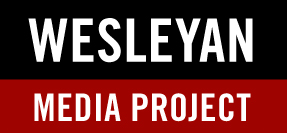
c/o Wesleyan Media Project
If the thought of pass-through entities and tax inversion leaves you feeling disoriented, you may be in for a few more months of discomfort. While President Donald Trump signed the Tax Cuts and Jobs Act into law on Dec. 22, 2017, promising that economic stimulus would drive private investment and boost growth by 3 to 5 percent annually, the business of selling the new tax policy has just begun. With midterm elections in November, both parties are accelerating campaigns to define the Trump Administration’s major legislative achievement in the minds of the American public.
“Messaging after a bill becomes a law is all about accountability,” Associate Professor of Government Erika Franklin Fowler told The Argus.
In their brand of accountability, progressive groups like the Not One Penny campaign hope to instill in the minds of American voters the view that Republican tax reform is a corporate giveaway that foots lower and middle-income Americans the bill for tax cuts that benefit the rich. The group plans to spend millions on anti-tax bill ads in 2018, and hopes to build on last April’s Tax March, as well as the energy of progressives who helped stymie the repeal of Obamacare in the Senate. Not to be outdone by their liberal counterparts, the American Action Network, a center-right not-for-profit advocacy group, has pledged to spend $10 million on ads to promote the bill in congressional swing districts, while America First Policies released a series of pro-tax reform advertisements last Christmas featuring happy workers and their families.
Fowler is a director of the Wesleyan Media Project (WMP), which was formed in 2010 to track advertising in federal elections. The group’s work has expanded beyond campaign finance to include a comprehensive analysis of local news coverage of Obamacare that has been featured in publications like The New York Times and The Washington Post. This winter, Fowler partnered with her colleague and congressional scholar, Assistant Professor of Government Logan Dancey, to conduct research and administer a survey on public opinion surrounding tax policy.
“The tax bill was a very consequential piece of legislation that made significant changes to the tax code while also repealing the individual mandate aspect of the Affordable Care Act,” Dancey wrote in an email to The Argus.“I hope that our research will provide better insight into what the public knows about the different provisions of the bill and how it evaluates both individual aspects of the bill and the legislation as a whole. We are also hoping that it will provide insight into how voters evaluate both the policy content of major legislation and the process by which such legislation is passed.”
The duo hopes to present their work at the American Political Science Association’s conference in August. They are currently preparing a proposal to submit to the APSA and plan to incorporate WMP data on advertising and messaging to provide independent variables to test differing perceptions of tax reform. Fowler believes that the Democrats’ failure to message aggressively on Obamacare will serve as an excellent comparative case to the battle of persuasion on tax reform.
“In the case of the Obama Administration, the Affordable Care Act messaging came solely from Republicans,” Fowler said. “Once they had passed the ACA, Democrats were concerned that any messaging would be divisive, so, therefore, they choose not to message on it. The closest they came was saying they stood up to insurance companies, whereas Republicans were much more united in selling it as bad policy and a government takeover.”
Obamacare polling remained relatively stable, continuing to divide along highly partisan lines for years. But when congressional Republicans tried to repeal the legislation last summer, Democrats were able to circumvent the traditional news media-style of portraying political conflict through a “game frame” pitting Democrats against Republicans. Fowler believes that the nature of the repeal effort, which put real people whose health insurance might be terminated in the crosshairs, allowed progressives to promote with real emotional energy what felt like tangibly beneficial legislation to many people for the first time.
Democrats will face several challenges in their campaign against tax reform. While the tax bill was quite unpopular when it was passed, with a favorability of 37 percent in December, the bill’s approval rating has surged in recent months, sitting at 51 percent, according to a recent New York Times-SurveyMonkey poll conducted between Feb. 5 and Feb. 11. Negative advertising attacking the legislation may be especially tricky because of what Fowler calls “non-aligned time frames” or features of the tax bill that hide potentially punitive rules that do not kick in until after the midterms. For example, most individual cuts do not expire until 2025. Democrats will also need to deflect stories about companies like Walmart offering bonuses and other benefits to workers that Republicans will point to as evidence of the bill’s efficacy.
“It is a very large policy change, but the ways it will filter down to the American public are not going to be as crystal clear as we may think they would be,” Fowler said. “For example, people are filling out their taxes this year, and there will be a temptation to say anything that happens is because of the tax plan, when we know most of the changes go into effect next year after the midterm elections.”
Whether or not Democrats can recreate the energy that fueled the movement opposing the Obamacare repeal, and stem the rising tide of support for tax reform, will be a major storyline come November.
Aaron Stagoff-Belfort can be reached at astagoffbelf@wesleyan.edu
Comments are closed